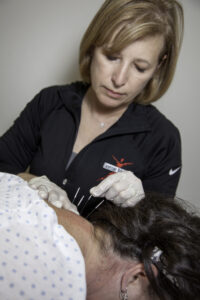Headlines
Local Physical Therapist Treats Patients for Pain with New Technique
Pain was Alyce Krouse’s constant companion.

Physical Therapist Kelly Shinall of Cornerstone Rehabilitation in Oxford, treats Alyce Krouse of Oxford with dry needling, a technique of inserting a needle into the patient’s problem area to manipulate it. Shinall is one of only 48 PT’s certified in the procedure in Mississippi. Unlike in acupuncture, the needles are used to actually manipulate and treat the painful area.
Photo courtesy Stan O’Dell
Her physician diagnosed the pain in her hip and leg as a result of bulging disks and treated her with traction, nerve block injections and physical therapy. Nothing helped.
“I was not feeling any relief,” says Krouse, a pre-school teacher.
Then her physical therapist (PT), Kelly Shinall of Cornerstone Rehabilitation in Oxford, suggested an unusual new technique called functional dry needling, in which the PT inserts one or more small needles into the patient’s problem area.
“When people first hear of it, they think it must be like acupuncture,” says Shinall, one of only 48 PT’s certified in dry needling in Mississippi. “But the only thing it has in common with acupuncture is the use of a needle. It is based on medical scientific principles, not Eastern medicine.”
Dry needling treats pain and impaired movement by stimulating “underlying myofascial trigger points, muscular and connective tissues,” according to The American Physical Therapy Association.
Since Shinall was certified in November, she has successfully treated multiple patients. (See accompanying article for a personal story.)
“I’ve already seen some very promising, almost dramatic results, from patients on whom other therapies had not helped,” Shinall says. “It’s certainly not a miracle, but it can be a very helpful tool to add to existing physical therapy methods.”
Shinall learned the power of the technique herself during her first training seminar, when she developed a migraine headache. The workshop leaders administered dry needle therapy to her neck muscles.
“I’ve suffered from migraines for years and normally, they put me to bed for at least a day before I can function normally,” Shinall says. “But with the treatment, I was able to rejoin the training within a few hours.”
However, the therapy is not for everyone, including patients with certain health conditions or a metal allergy, Shinall cautions.
However, it has helped Krouse, who is still being treated.
“I have definitely seen results,” Krouse says. ”The pain and numbness have been significantly reduced.”
Physical therapists may evaluate and treat patients who have been diagnosed with a treatable condition in the last 180 day without a physician’s referral, according to the Mississippi Board of Physical Therapy website.
Some conditions or insurance companies may require a physician’s referral, though. Patients may take that referral to any physical therapist they choose.
For more information about functional dry needling or about Cornerstone Rehabilitation, call (662) 238-2800.
Robin Street is a lecturer at the Meek School of Journalism and New Media and can be reached at rbstreet@olemiss.edu.








































Tom Messina, LAc, MS, Dipl. OM, LMT
March 13, 2015 at 11:01 pm
Dry needling is acupuncture we learned that technique in acupuncture school. Acupuncture has a basis in science it’s been studied for over 30 years by the scientific community.
More injuries have occurred by the hands of PT’s and Chiropractors preforming what they call dry needling. Their training consists of about 23 hours,
My training Consists of hundreds of hours of actual needling classes plus 1000 hours of clinical practice besides 1500 hours of Eastern medicine theory and 1500 hours of Western medicine theory.
Also dry needling (acupuncture) is not in a Physical Therapists scope of practice, some states have banned PT’s from doing dry needling. PT’s should do what they do best and stop stealing our medicine.
boyd
March 14, 2015 at 9:04 am
THEFT! So called ‘Dry Needling’ is NOTHING other than dumbed down, poorly trained acupuncture. Why in the world would a prospective pain patient forego a clinical history of 1000’s of years and a clinician with 3+ years of ‘needle training’ … and choose a PT who has roughly 60 hours of training? CHECK the safety record for PT’s ‘dry needling’… DISGRACEFUL 🙁
Michel Czehatowski
March 15, 2015 at 5:12 pm
Call it “dry needling” but she is using acupuncture needles. My understanding of “dry needling” is that it consists of using a hypodermic needle without injecting any substance. This lady would probably be sued for practicing medicine without a license in California. She certainly does not have the training to do acupuncture under any name. Patients beware!
Luke Bynum PT, DPT
March 18, 2015 at 3:20 pm
As I read the above comments from the three acupuncturist regarding a Physical Therapist performing dry needling, I envision them stomping their feet and yelling.. “Dry needling is mine! No one else can have it!” Also, as I read their comments, it is clear to see their responses are based on emotion and a knee jerk reaction to the feeling that another profession is “stealing” something from them. Their wording is harsh and includes – theft, stealing our medicine, disgraceful, dumbed down, and patients beware (which is my personal favorite.)
So, instead of emotion, how about we present some evidence. Physical Therapists have been safely performing dry needling since 1984. Maryland was the first state to allow the performance of this technique and since 1984, there have been no adverse events reported to the Maryland State Board of Physical Therapy (APTA, 2012). Furthermore, the US Federation of State Boards of Physical Therapy Examination, Licensure, and Disciplinary Database has NO entries in ANY jurisdiction or discipline reported for harm caused by dry needling performed by Physical Therapists (APTA, 2012). In response to “CHECK the safety record for PT’s ‘dry needling’… DISGRACEFUL ” and “More injuries have occurred by the hands of PT’s and Chiropractors preforming what they call dry needling”…we just did and there was little supporting evidence to those claims.
Another argument presented was the lack of education and training for a Physical Therapist to perform dry needling. Let me clarify the training for a Physical Therapist. The entry level Doctor of Physical Therapy degree is a culmination of nearly 3000 hours of course and clinical work. A Doctor of Physical Therapy is an expert in musculoskeletal anatomy, neuromuscular anatomy, and pain sciences. Dry needling is the insertion of a needle into a muscle to treat muscular pain. We are the muscular experts and we can safely insert a needle into a muscle without causing adverse events as the evidence has stated above. After a seven year degree, and the title of Doctor of Physical Therapy, a Physical Therapist can attend seminars to learn the technique of dry needling and yes this only requires around sixty hours of extra training. But, you must remember, the Therapist is already an expert in musculoskeletal anatomy, so the course work is mostly learning the technique.
Adverse events happen in medicine. Adverse events happen in Physical Therapy. Adverse events happen in Acupuncture. Adverse events happen in Chiropractic care. Adverse events happen in life. You can find instances of pneumothorax in the hands of acupuncturist and in the hands of Physical Therapists. If you perform needling around a lung field, it is a risk. But for the acupuncturist above to state more injuries have occurred in the hands of Physical Therapists is simply not supported in the literature.
The acupuncturist arguing otherwise is nothing more than a turf war and a reaction to the feeling that a Physical Therapist is “stealing” something from them (as you can see in the above comments).
I have safely performed dry needling as a Doctor of Physical Therapy in Oxford, MS and for the United States Navy for two years without adverse event and with hundreds of satisfied patients.
Kyrie Lizik, MSOM C.Ac.
January 22, 2016 at 7:06 pm
There is so much misleading information about acupuncture in this article. Im tired of Physical Therapists proclaiming dry needling as a “new, unique technique”. It is not new!! It is acupuncture! We acupuncturists also manipulate needles for pain relief. You are misrepresenting our profession to satisfy your own egotistical ends. Or you are simply ignorant.
anonymous
February 2, 2016 at 7:48 pm
Physical therapists stole acupuncture from acupuncturists. It is amazing that the western medical world had to have it come from one of their own professions in order to accept it. What the physical therapists are doing is definitely acupuncture. The original dry needling were hyperdermic needles in muscle motor trigger points!